*NURSING > QUESTIONS & ANSWERS > Nursing School Entrance Exams Prep Practice Test Three, HESI. With Answer Key and Answer Explanation (All)
Nursing School Entrance Exams Prep Practice Test Three, HESI. With Answer Key and Answer Explanations
Document Content and Description Below
Nursing School Entrance Exams Prep 2019–2020 Practice Test Three, HESI. With Answer Key and Answer Explanations READING COMPREHENSION Questions 1–10 are based on the following passage, which w... as written in 1992 by France Bequette, a writer who specializes in environmental issues. The ozone layer, the fragile layer of gas surrounding our planet between 7 and 30 miles above the Earth’s surface, is being rapidly depleted. Seasonally occurring holes have appeared in it over the Poles and, recently, over densely populated temperate regions of the northern hemisphere. The threat is serious because the ozone layer protects the Earth from the sun’s ultraviolet radiation, which is harmful to all living organisms. Even though the layer is many miles thick, the atmosphere in it is tenuous and the total amount of ozone, compared with other atmospheric gases, is small. Ozone is highly reactive to chlorine, hydrogen, and nitrogen. Of these, chlorine is the most dangerous since it is very stable and long-lived. When chlorine compounds reach the stratosphere, they bond with and destroy ozone molecules, with consequent repercussions for life on Earth. In 1958, researchers began noticing seasonal variations in the ozone layer above the South Pole. Between June and October the ozone content steadily fell, followed by a sudden increase in November. These fluctuations appeared to result from the natural effects of wind and temperature. But while the low October levels remained constant until 1979, the total ozone content over the Pole was steadily diminishing. In 1985, public opinion was finally roused by reports of a “hole” in the layer. The culprits responsible for the hole were identified as compounds known as chlorofluorocarbons, or CFCs. CFCs are compounds of chlorine and fluorine. Nonflammable, nontoxic, and noncorrosive, they have been widely used in industry since the 1950s, mostly as refrigerants and propellants and in making plastic foam and insulation. In 1989 CFCs represented a sizeable market valued at over $1.5 billion and a labor force of 1.6 million. But with CFCs implicated in ozone depletion, the question arose as to whether we were willing to risk an increase in cases of skin cancer, eye ailments, even a lowering of the human immune defense system—all effects of further loss of the ozone layer. And not only humans would suffer. So would plant life. Phytoplankton, the first link in the ocean food chain and vital to the survival of most marine species, would not be able to survive near the ocean surface, which is where these organisms grow. In 1990, 70 countries agreed to stop producing CFCs by the year 2000. In late 1991, however, scientists noticed a depletion of the ozone layer over the Arctic. In 1992 it was announced that the layer was depleting faster than expected and that it was also declining over the northern hemisphere. Scientists believe that natural events are making the problem worse. The Pinatubo volcano in the Philippines, which erupted in June 1991, released 12 million tons of damaging volcanic gases into the atmosphere. Even if the whole world agreed today to stop all production and use of CFCs, this would not solve the problem. A single chlorine molecule can destroy 10,000–100,000 molecules of ozone. Furthermore, CFCs have a lifespan of 75–400 years and they take ten years to reach the ozone layer. In other words, what we are experiencing today results from CFCs emitted ten years ago. Researchers are working hard to find substitute products. Some are too dangerous because they are highly flammable; others may prove to be toxic and to contribute to the greenhouse effect—to the process of global warming. Nevertheless, even if here is no denying that the atmosphere is in a state of disturbance, nobody can say that the situation will not improve, either in the short or the long term, especially if we ourselves lend a hand. 1. Which is the main idea of the second paragraph? (A) The ozone layer is fragile and needs protection. (B) Ozone is highly reactive to chlorine, hydrogen, and nitrogen. (C) Chlorine compounds pose a significant risk to the ozone layer. (D) Chlorine is stable and long-lived. 2. Which is the meaning of the word repercussions as used in the second paragraph? (A) Conclusions. (B) Effects. (C) Injuries. (D) Questions. 3. Which information is not given as a detail in the passage? (A) CFCs take ten years to reach the ozone layer. (B) Phytoplankton live near the surface of the ocean. (C) Loss of the ozone layer could lead to an increase in skin cancer rates. (D) CFCs were phased out as a result of the Montreal Protocol. 4. Which answer option is the best summary of the passage? (A) The ozone layer is located between 7 and 30 miles above the surface of the Earth, and it is in danger as a consequence of global warming. (B) Depletion of the ozone layer can lead to higher rates of skin cancer and widespread loss of ocean life, and banning CFCs will help solve this problem. (C) The ozone layer is at risk of significant depletion due to the presence CFCs in the atmosphere, even if further CFC use were to stop completely. However, humans can improve the situation if they rise to the challenge. (D) CFCs are chemical compounds widely used in refrigerants and propellants. The compounds are dangerous to the ozone layer but represent more than $1.5 billion in revenue to plastics and chemical companies. 5. Why does the author mention phytoplankton in the fifth paragraph? (A) To show that a depleted ozone layer affects more than just humans. (B) To show how fragile ocean life can be. (C) To compare the value of marine species to the value of CFCs. (D) To explain where much of the planet’s photosynthesis occurs. 6. Which is the author’s primary purpose in writing this piece? (A) To convince readers to stop using CFCs. (B) To inform readers about the dangers of CFCs. (C) To argue that the planet is warming due to a depleted ozone layer. (D) To explain the nature of the ozone layer. 7. Which statement is an opinion? (A) The ozone layer has shown steady depletion for several decades. (B) Chlorine-based compounds can be especially dangerous to the ozone layer because of chlorine’s stability and longevity. (C) CFCs represented more than $1.5 billion in market value in 1989. (D) CFCs pose a greater long-term threat to human well-being than any other risk factor. 8. Which detail supports the idea that CFCs pose a long-term threat to the ozone layer? (A) A single chlorine molecule can destroy 10,000–100,000 ozone molecules. (B) CFCs have been in wide use since the 1950s. (C) CFCs have a lifespan of 75–400 years and take ten years to reach the ozone layer. (D) The ozone layer protects the Earth from the sun’s ultraviolet radiation. 9. Why does the author mention the Arctic in the sixth paragraph? (A) To illustrate how ozone depletion has worsened and spread. (B) To provide a counterargument to the idea that ozone depletion is a global problem. (C) To show that natural phenomena can also play a role in ozone depletion. (D) To explain how weather patterns affect the ozone layer. 10. Which is the meaning of the word fluctuations as used in the second paragraph? (A) Damages. (B) Depletions. (C) Variations. (D) Uncertainties. VOCABULARY 1. Select the meaning of the underlined word in the following sentence. Through simple diffusion, oxygen can permeate the cell membrane. (A) Pass through. (B) Dissolve. (C) Damage. (D) Reinforce. 2. Select the meaning of the underlined word in the following sentence. After tests were completed, he was told that the growth on his leg was benign. (A) Spreading. (B) Cancerous. (C) Harmless. (D) Common. 3. Which is the best definition of the word vascular? (A) Pertaining to breathing. (B) Pertaining to blood vessels. (C) Pertaining to dementia. (D) Pertaining to the heart. 4. Select the meaning of the underlined word in the following sentence. After noting that the patient’s mood was labile, the nurse discovered that he had stopped taking his prescribed antipsychotic medication. (A) Elevated. (B) Depressed. (C) Hostile. (D) Unstable. 5. Which word meaning “provided evidence against” best fits in the sentence? The patient’s continued dizziness and slurred speech his discharge from the hospital. (A) Conducted. (B) Contraindicated. (C) Contracted. (D) Constricted. 6. Select the meaning of the underlined word in the following sentence. Although the victim was struck by a cyclist at high speed, she was ambulatory when she arrived at the emergency room. (A) Able to walk. (B) Able to be carried. (C) Losing consciousness. (D) Transported by a vehicle. 7. Which is the best definition of the word transdermal? (A) Through or by way of the skin. (B) Through or by way of the mouth. (C) Through or by way of the blood. (D) Through or by way of the extremities. 8. Which word meaning “sample” best fits in the sentence? The nurse took the patient’s tissue to the lab for testing. (A) Necropsy. (B) Specimen. (C) Example. (D) Spectrum. 9. Which is the best definition of the word therapeutic? (A) Toxic. (B) Prescribed. (C) Additional. (D) Curative. 10. Which word meaning “open” best fits in the following sentence? The nurse had to ensure that the victim maintained a/an airway during the procedure. (A) Occluded. (B) Constricted. (C) Patent. (D) Latent. GRAMMAR 1. Which sentence is grammatically correct? (A) There are not nearly enough sterile needles to administer the vaccination to everyone. (B) Despite the doctor’s warning, he was not ready for the strong affects of the medication. (C) Her and me both took patients up to Radiology at around the same time. (D) The couple claimed that the unattended backpack turned in to the reception desk was their’s. 2. Select the best words for the blanks in the following sentence. Anyone who drive a manual transmission vehicle also be able to drive an automatic transmission vehicle. (A) Shall; shall not. (B) Might; must not. (C) Should; can. (D) Can; should. 3. Which word is used incorrectly in this sentence? The difference among ibuprofen and aspirin is significant, particularly with regard to side effects. (A) Difference. (B) Among. (C) Is. (D) With. 4. Which sentence is grammatically incorrect? (A) The gurney which was in the hallway belonged to the ambulance service, while the gurney in the drop-off bay belonged to the hospital. (B) There was a large amount of paperwork still incomplete when he was admitted. (C) Hannah thought she did badly on her test, but she ended up scoring near the top of her class. (D) The nurse read off the list of potential side effects to the blind patient. 5. Which word from the following sentence is an adverb? Gerry often found himself checking in with other night-shift staff during his off-hours. (A) Often. (B) In. (C) Other. (D) During. 6. Which word is used incorrectly in this sentence? The patients in the urgent care facility had been waiting for hours and was growing impatient. (A) Facility. (B) Had. (C) Waiting. (D) Was. 7. Which word from the following sentence is a conjunction? The nurse could not find an available examination room, so he conducted the screening in an empty office. (A) Could. (B) Available. (C) So. (D) In. 8. Which sentence contains sexist language? (A) The man helped the elderly woman complete her medical history forms. (B) If a fireman wants to stand a good chance of survival, he needs to have properly maintained safety equipment. (C) The server presented the lunch bill to Harvey, even though Sandra was the manager of the department. (D) If a person is interested in becoming a medical examiner, he or she should research the amount of schooling required for such a job. 9. Select the best word for the blank in the following sentence. Ms. Parker was the patient medication was incorrectly dosed. (A) Who. (B) Whom. (C) Who’s. (D) Whose. 10. Which word from the following sentence is a preposition? The third-shift crew all arrived very late, but within ten minutes of each other. (A) All. (B) Very. (C) Within. (D) Each. MATHEMATICS 1. The number 16 is 25% of which number? (A) 4 (B) 48 (C) 64 (D) 96 2. Which is written as a percent? (A) 32% (B) 37.5% (C) 42.5% (D) 45% 3. Convert the following 12-hour clock time to military time: 7:41:23 PM (A) 07:41:23 hours (B) 17:41:23 hours (C) 19:41:23 hours (D) 20:41:23 hours 4. Solve for x: −2x + 3 = x − 15 (A) −6 (B) −3 (C) 3 (D) 6 5. Which ratio accurately expresses ? (A) 3:8 (B) 5:9 (C) 6:18 (D) 9:33 6. Which answer option is 0.75 expressed as a fraction? (A) (B) (C) (D) 7. What is ? (A) (B) (C) (D) 8. What is ? (A) (B) (C) (D) 9. Solve for x: 5x − 7 = x + 5 (A) −4 (B) 2 (C) 3 (D) 12 10. If x = 5, y = 8, and z = 10, what is the value of the expression x2 + 3(y − z)? (A) 19 (B) 31 (C) 39 (D) 79 BIOLOGY 1. Which of these is a distinguishing characteristic of eukaryotic cells? (A) The ability to reproduce. (B) A defined, membrane-enclosed nucleus. (C) An outer cell membrane. (D) The presence of ribosomes for protein production. 2. Which is the best definition of mitosis? (A) The simplest form of asexual reproduction. (B) A five-stage process of cell division. (C) A process that mainly occurs in mammals. (D) The process used for sex cell production. 3. Which answer option is not one of the four nitrogenous bases of DNA? (A) Adenine. (B) Cholosyne. (C) Guanine. (D) Thymine. 4. In the scientific method, which step comes first? (A) Conclusion. (B) Experiment. (C) Hypothesis. (D) Observation. 5. Which is the most inclusive level of classification? (A) Class. (B) Family. (C) Phylum. (D) Species. CHEMISTRY 1. Which statement about bases is true? (A) They are electron donors. (B) They are electron acceptors. (C) They are proton donors. (D) They are proton acceptors. 2. Which is the process by which the liver can create glucose from proteins and fats? (A) Glycolysis. (B) Gluconeogenesis. (C) Double replacement. (D) Oxidative phosphorylation. 3. Which is the simplest form of a carbohydrate? (A) Disaccharide. (B) Monosaccharide. (C) Oligosaccharide. (D) Polysaccharide. 4. To which other DNA base is adenine always bound? (A) Cytosine. (B) Deoxyribose. (C) Guanine. (D) Thymine. 5. Which statement about redox reactions is true? (A) Oxidation involves the loss of electrons, while reduction involves the gain of electrons. (B) Oxidation involves the gain of electrons, while reduction involves the loss of electrons. (C) A substance that is oxidized gains a positive charge. (D) An element in its natural state can have a positive or negative charge. ANATOMY AND PHYSIOLOGY 1. If a patient is described as having a distal leg fracture, where is the injury most likely to be located? (A) At the top of the thigh. (B) Along the outside of the thigh. (C) Near the ankle. (D) Near the knee. 2. Which tissue is not one of the four fundamental tissues of the human body? (A) Connective tissue. (B) Epithelial tissue. (C) Cardiac tissue. (D) Nerve tissue. 3. Which anatomical system creates blood cells and stores minerals? (A) Digestive system. (B) Endocrine system. (C) Muscular system. (D) Skeletal system. 4. Which is the outermost layer of the epidermis called? (A) Stratum basale. (B) Stratum corneum. (C) Stratum granulosum. (D) Stratum spinosum. 5. Which structure is part of the peripheral nervous system? (A) Cerebellum. (B) Optic nerve. (C) Spinal cord. (D) Vagus nerve. PHYSICS 1. A car travels for 15 minutes and covers a distance of 27 kilometers. Which is the average speed of the car? (A) 3.0 m/s (B) 18 m/s (C) 30 m/s (D) 40.5 m/s 2. A skateboard is rolled down a large hill. Its initial speed is 2 m/s, and it travels down the hill for 30 seconds. The skateboard’s final speed is 8 m/s. Which is the magnitude of the skateboard’s acceleration? (A) 0.2 m/s2 (B) 0.33 m/s2 (C) 1.5 m/s2 (D) 2 m/s2 3. A box with a mass of 10 kg rests on a frictionless surface. The box is being pushed to the north by a force of 36N, while another force of 48N pushes the box to the south. Which is the magnitude of acceleration of the box? (A) 0.12 m/s2 (B) 0.84 m/s2 (C) 1.2 m/s2 (D) 8.4 m/s2 4. In waves, the maximum displacement from equilibrium known as which of these? (A) Amplitude. (B) Crest. (C) Frequency. (D) Wavelength. 5. A circuit contains several resistors placed in series. If the circuit is wired to a 200-V power supply and the current is measured at 4 amps, which is the total resistance in the circuit? (A) 20 ohms (B) 50 ohms (C) 100 ohms (D) 800 ohms [Show More]
Last updated: 1 month ago
Preview 1 out of 30 pages
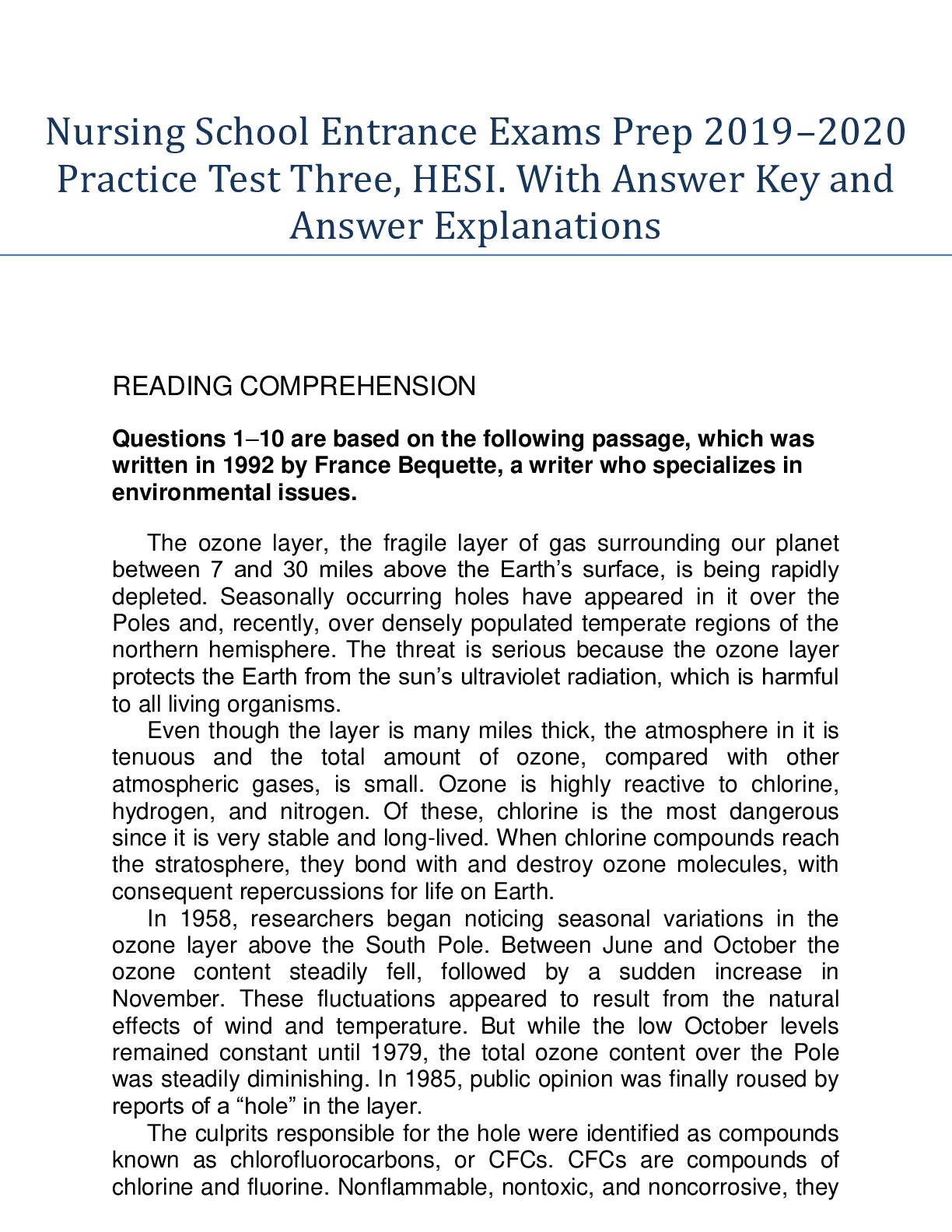
Reviews( 0 )
Recommended For You
*NURSING> QUESTIONS & ANSWERS > Nursing School Entrance Exams Prep Practice Test Two, Kaplan. With Answer Key and Answer Explanations (All)
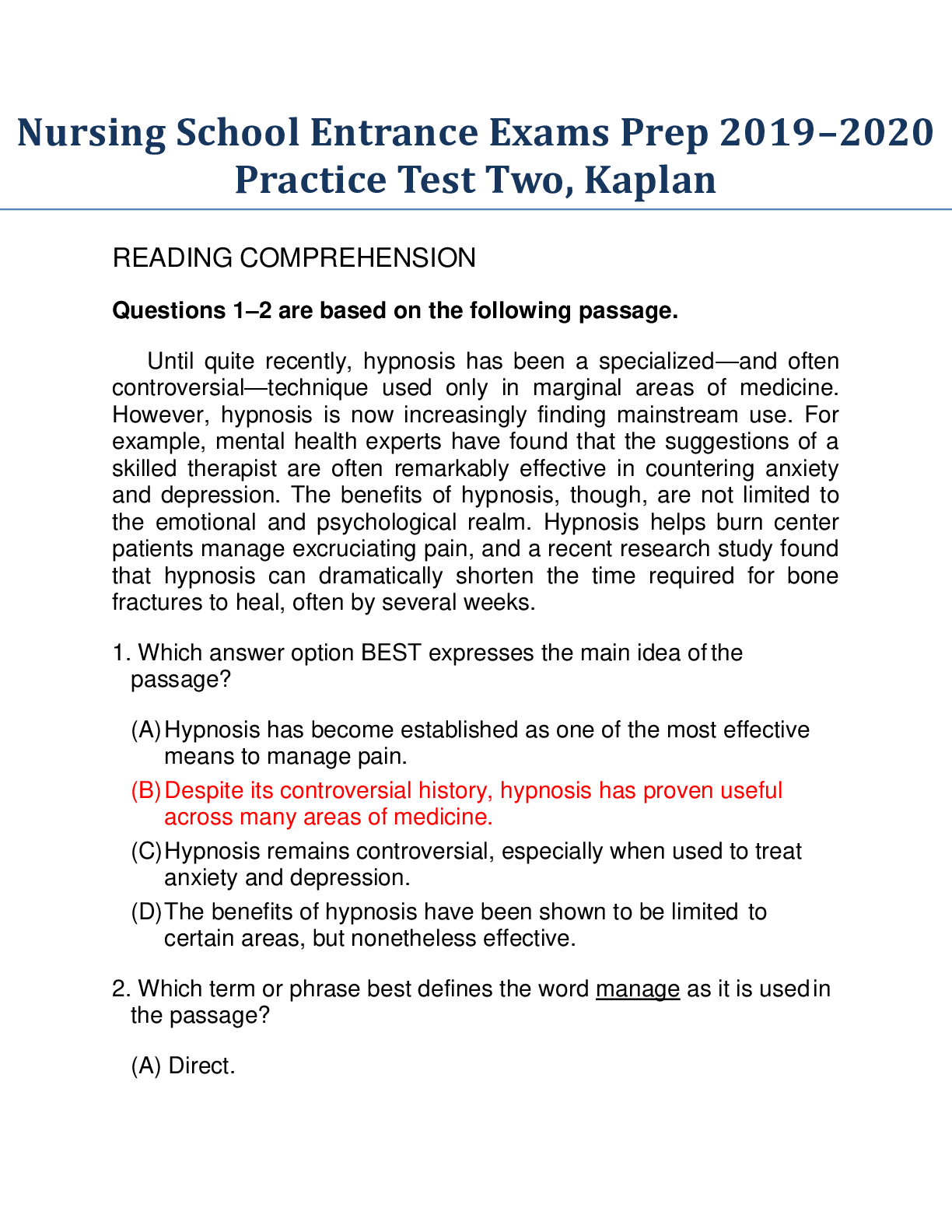
Nursing School Entrance Exams Prep Practice Test Two, Kaplan. With Answer Key and Answer Explanations
READING COMPREHENSION Questions 1–2 are based on the following passage. Until quite recently, hypnosis has been a specialized—and often controversial—technique used only in marginal areas of medicin...
By Kirsch , Uploaded: Jun 17, 2020
$15
*NURSING> QUESTIONS & ANSWERS > Nursing School Entrance Exams Prep 2019–2020: Practice Test One, Kaplan Includes Answer Key with Answers and Explanations (All)

Nursing School Entrance Exams Prep 2019–2020: Practice Test One, Kaplan Includes Answer Key with Answers and Explanations
Nursing School Entrance Exams Prep 2019–2020 Practice Test One, Kaplan READING COMPREHENSION Questions 1–2 are based on the following passage. Many mammals instinctively raise their fur when they a...
By Kirsch , Uploaded: Jun 17, 2020
$8.5
*NURSING> QUESTIONS & ANSWERS > Nursing School Entrance Exams Prep 2019–2020 Practice Test Three, HESI. With Answer Key and Answer Explanations (All)
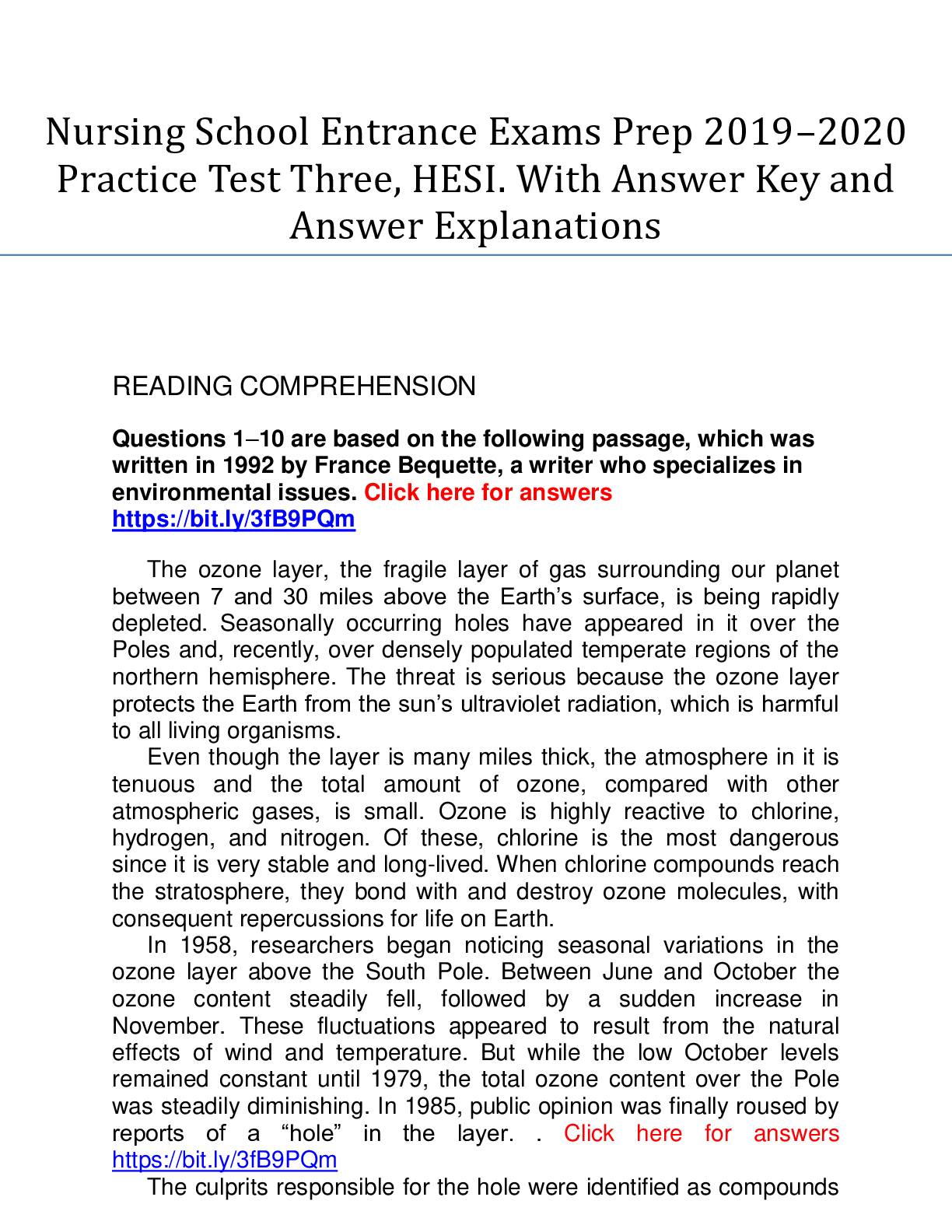
Nursing School Entrance Exams Prep 2019–2020 Practice Test Three, HESI. With Answer Key and Answer Explanations
Nursing School Entrance Exams Prep 2019–2020 Practice Test Three, HESI. With Answer Key and Answer Explanations
By NechemiaYoung , Uploaded: Aug 26, 2021
$8.5
*NURSING> QUESTIONS & ANSWERS > Nursing School Entrance Exams Prep 2019–2020 Practice Test Four, HESI. With Answer Key and Answer Explanations (All)
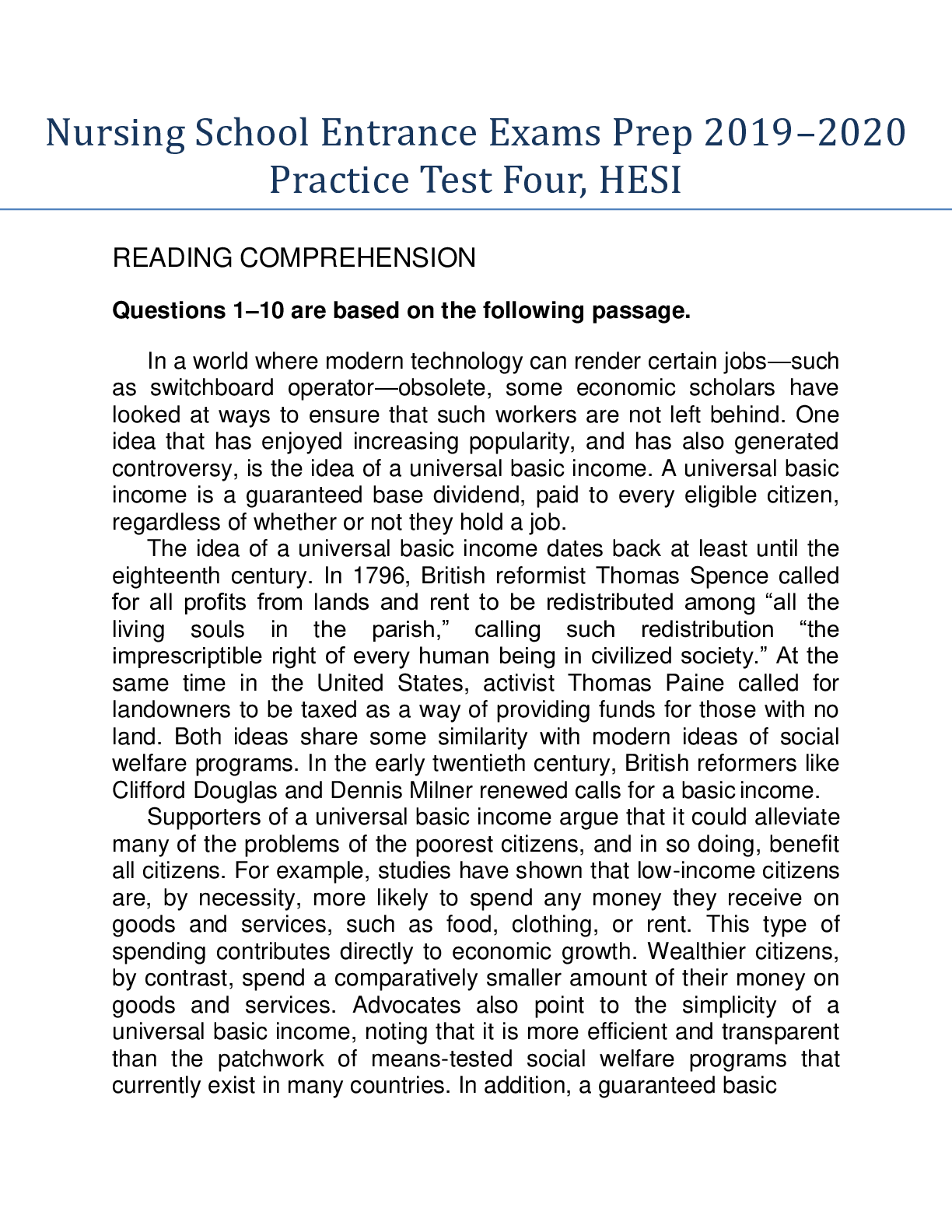
Nursing School Entrance Exams Prep 2019–2020 Practice Test Four, HESI. With Answer Key and Answer Explanations
Nursing School Entrance Exams Prep 2019–2020 Practice Test Four, HESI READING COMPREHENSION Questions 1–10 are based on the following passage. In a world where modern technology can render certain...
By Kirsch , Uploaded: Jun 18, 2020
$6
*NURSING> QUESTIONS & ANSWERS > NCSBN TEST BANK for the NCLEX-RN & NCLEX-PN. Contains More than 2000 Q&A Plus Review and Rationale in 517 PAGES. (All)

NCSBN TEST BANK for the NCLEX-RN & NCLEX-PN. Contains More than 2000 Q&A Plus Review and Rationale in 517 PAGES.
NCSBN TEST BANK -for the NCLEX-RN & NCLEX-PN. Updated 2022/2023. Contains More than 2000 Q&A Plus Review and Rationale in 517 PAGES. (All Testable Questions for NCLEX-RN & NCLEX-PN)
By Expert1 , Uploaded: Jul 28, 2020
$20
Business> QUESTIONS & ANSWERS > CLM 031 EXAM (All)
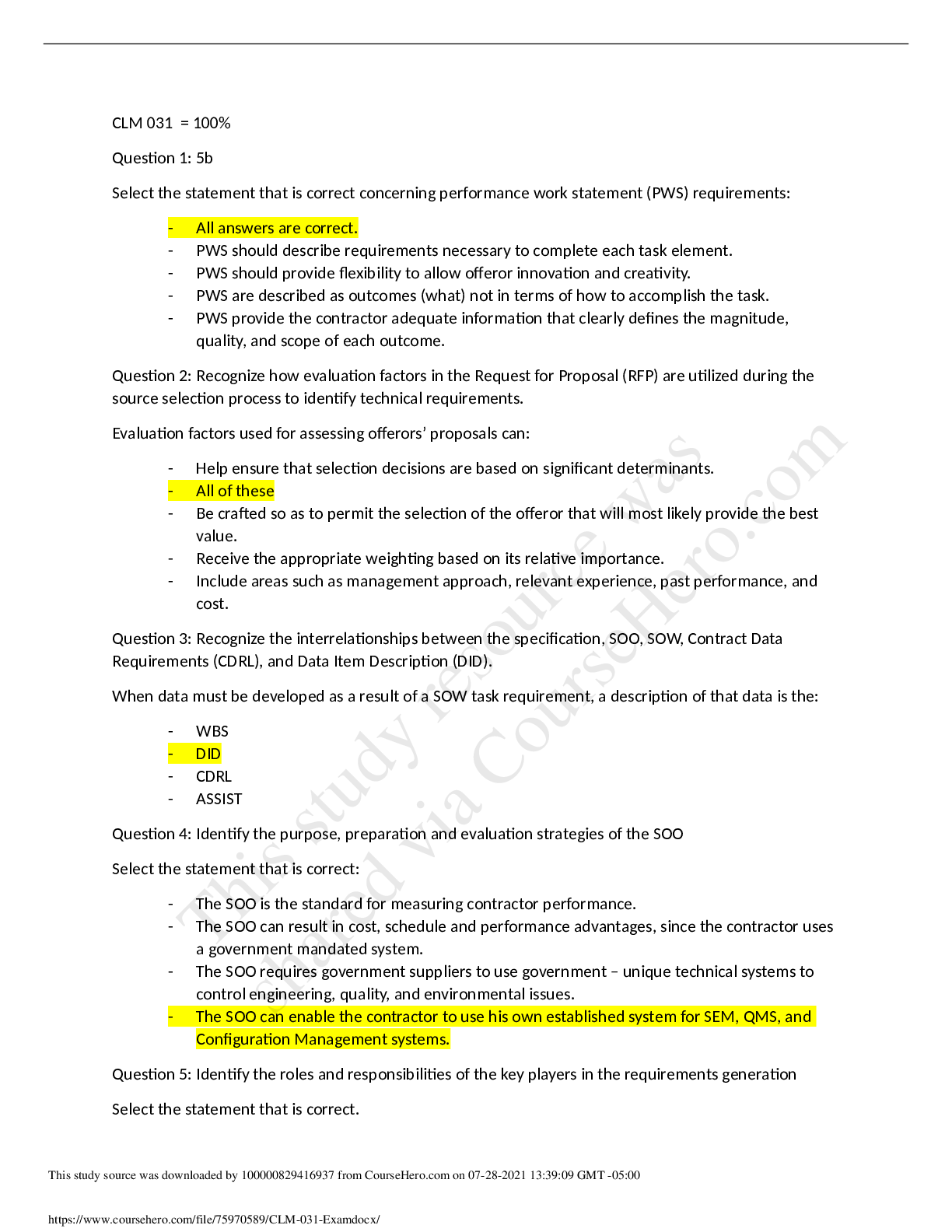
CLM 031 EXAM
CLM 031 = 100% Question 1: 5b Select the statement that is correct concerning performance work statement (PWS) requirements: - All answers are correct. - PWS should describe requirements necessary...
By Book Worm, Certified , Uploaded: Nov 03, 2022
$5
*NURSING> QUESTIONS & ANSWERS > PHIL 347 Week 6 Checkpoint Quiz. Score 100/100 (All)
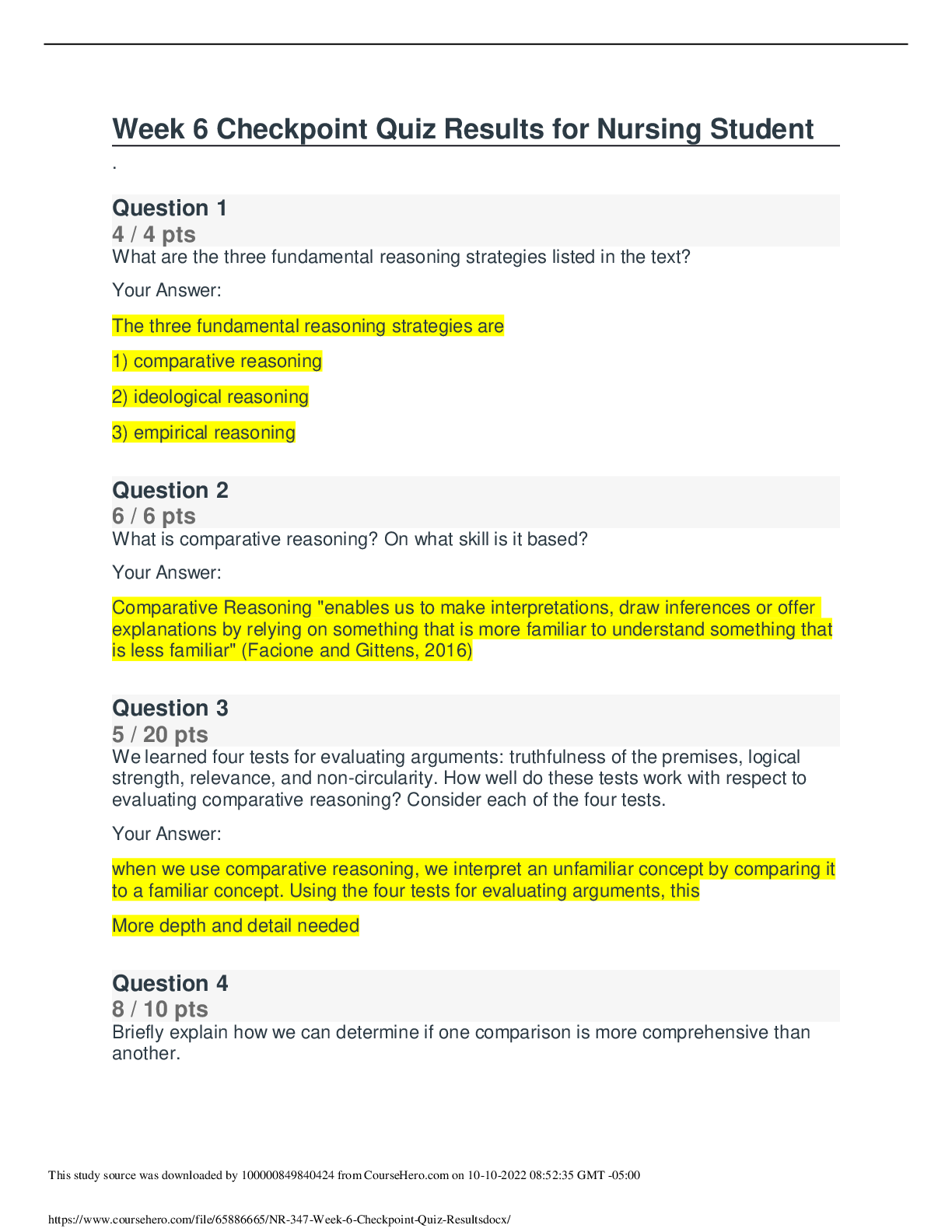
PHIL 347 Week 6 Checkpoint Quiz. Score 100/100
Question: What are the three fundamental reasoning strategies listed in the text? Question: What is comparative reasoning? On what skill is it based? Question: We learned four tests for evaluating...
By Amanda Rosales , Uploaded: Mar 24, 2021
$7
Business> QUESTIONS & ANSWERS > BUSINESS 1007 (All)

BUSINESS 1007
BUSINESS 1007 07 Key 1. (p. 178) Managers utilize organizational resources such as employees, information, and equipment to accomplish goals. 2. (p. 178) The main job of managers today is to w...
By Kirsch , Uploaded: Oct 19, 2019
$6
Anthropology> QUESTIONS & ANSWERS > KOR 352 FA19 101 week 8 Quiz. Already Graded A (All)

KOR 352 FA19 101 week 8 Quiz. Already Graded A
KOR 352 FA19 101: Week 8 Quiz Question 1 (0.25 points) Which of the following is not true of Kim and Finch’s observations during their field research in South Korea from 1997 to 2000? Question 1 o...
By Kirsch , Uploaded: Oct 17, 2019
$9
E-Commerce> QUESTIONS & ANSWERS > ESOC 316 Digital Commerce - University Of Arizona. Midterm Quiz. 20 Q&A. 100% Score (All)

ESOC 316 Digital Commerce - University Of Arizona. Midterm Quiz. 20 Q&A. 100% Score
ESOC 316 Digital Commerce - University Of Arizona. Midterm Quiz. 20 Q&A. 100% Score ESOC316 MIDTERM QUIZQuestion 6 (1 point) Saved Information has several properties that make information goods...
By Kirsch , Uploaded: Oct 15, 2019
$9.5
Document information
Connected school, study & course
About the document
Uploaded On
Jun 17, 2020
Number of pages
30
Written in
Additional information
This document has been written for:
Uploaded
Jun 17, 2020
Downloads
1
Views
85






